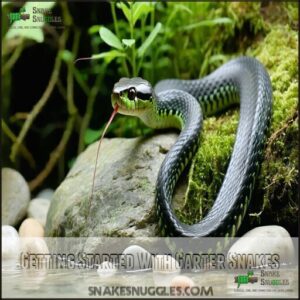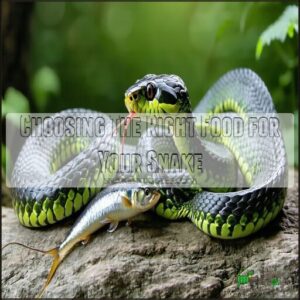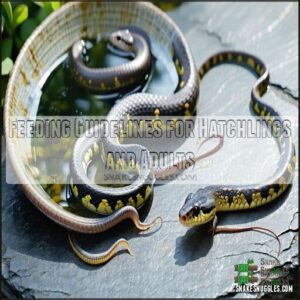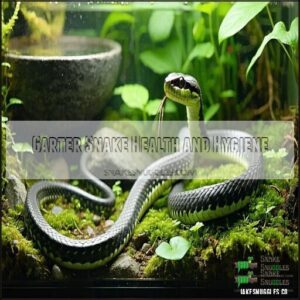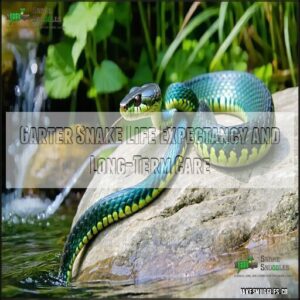This site is supported by our readers. We may earn a commission, at no cost to you, if you purchase through links.
 Garter snake pet care is straightforward once you’ve got the basics down.
Garter snake pet care is straightforward once you’ve got the basics down.
These snakes thrive in a secure vivarium with proper heating, ventilation, and hiding spots. Aim for a temperature gradient of 75-85°F and include fresh water for soaking.
They eat small fish, worms, and pinky mice—just avoid anything too large for their mouths. Handle them gently, as they’re curious but can get stressed if overhandled.
Keep the enclosure clean to prevent health issues, and watch for shedding trouble or signs of illness.
With proper care, garter snakes can live 8-10 years, making them a rewarding, low-maintenance companion. Proper heating, fresh water and secure vivarium
Table Of Contents
- Key Takeaways
- Getting Started With Garter Snakes
- Creating The Perfect Garter Snake Enclosure
- Garter Snake Diet and Feeding
- Heating and Lighting for Garter Snakes
- Garter Snake Health and Hygiene
- Handling and Interacting With Garter Snakes
- Garter Snake Habitat and Decoration
- Garter Snake Life Expectancy and Long-Term Care
- Frequently Asked Questions (FAQs)
- Are garter snakes easy to take care of?
- Can I keep a garter snake as a pet?
- How long do garter snakes live as pets?
- Do garter snakes like to be held?
- Is it OK to keep a wild garter snake as a pet?
- What is the lifespan of a garter snake?
- Do pet garter snakes need a heat lamp?
- How long do pet garter snakes live?
- Are garter snakes friendly?
- Can garter snakes recognize and respond to their owners voices?
- Conclusion
Key Takeaways
- Keep the enclosure warm with a temperature gradient of 75–85°F, and use secure lids to prevent escapes.
- Feed a varied diet like worms, fish, or pinky mice every 5–7 days for adults, avoiding wild-caught prey.
- Clean the vivarium regularly, replace soiled bedding, and maintain humidity between 40–60% for healthy shedding.
- Handle your snake gently and consistently to build trust while watching for signs of stress like striking or rapid movements.
Getting Started With Garter Snakes
When starting with garter snakes, it’s important to choose a healthy, beginner-friendly species like the Common Garter Snake.
Understanding their care requirements and behavior will help you create a comfortable environment for your new pet.
Choosing The Right Snake for You
Choosing the right garter snake involves finding a species that fits your needs and lifestyle. With a lifespan over ten years, they’re a long-term commitment.
Focus on key traits like species differences, size requirements, and temperament matters to guarantee an ideal match.
Garter snakes are beginner-friendly and easy to handle, making them a great entry-level pet.
Start by considering these factors:
- Size: Adult garter snakes range from 2–4 feet long.
- Temperament: Active and curious or calm and shy?
- Looks: Stripes, spots, or vibrant colors?
Careful selection guarantees a fun, rewarding pet care experience!
Understanding Garter Snake Behavior
Understanding garter snake behavior makes caring for these fascinating pets easier and more enjoyable.
Their activity patterns often include exploring through tongue flicks, a sign they feel safe. When calm, garter snakes may remain relaxed and loosely coiled. However, rapid movements or striking mean they’re stressed—give them space to settle.
Social interactions, even brief handling, build trust over time. Just make certain you handle them gently and regularly to encourage calm responses.
Escape attempts are common since they’re clever and curious. Keep enclosures secure to avoid surprises.
Pay attention to shedding behavior too—a garter snake in shed may act differently. Observing their captive adaptations helps you decode their mood and strengthens your bond.
Preparing for Your New Pet
A smooth start with your garter snake pet begins with good preparation. Think of it as setting the stage for an exciting new friendship.
Follow this checklist for success:
- Finding a reputable breeder: Guarantee a healthy pet by selecting a trusted source.
- Choosing subspecies: Pick one that matches your experience and preferences.
- Quarantine period: Isolate your new snake initially to monitor health.
- Initial supplies: Gather essentials like a secure enclosure, hides, and heating elements.
- Handling stress: Learn garter snake care basics to keep your new pet comfortable.
Providing the correct temperature gradient is essential for thermoregulation.
Preparation turns snake care into a fun, stress-free experience!
Creating The Perfect Garter Snake Enclosure
Building a proper enclosure for your garter snake guarantees their safety, health, and comfort.
You’ll need to balance size, temperature, and security to create an ideal home they can thrive in.
Choosing The Right Vivarium Size
Setting up your garter snake enclosure starts with the right terrarium size. A general rule for tank space is guaranteeing the enclosure’s perimeter is at least twice the length of the snake.
For baby garter snakes, a 10–15-gallon tank works, while adults need a 40-gallon or larger vivarium. Future growth plans should guide your choice—your snake will quickly outgrow a small tank.
The ideal garter snake enclosure balances comfort and function. Guarantee enough room for exploration, cozy hiding spots, and proper decor.
Vertical space needs are less critical since garter snakes aren’t climbers, but a wide, long terrarium gives them room to thrive.
Key considerations for tank size:
- Space per snake: Provide room for slithering and basking.
- Baby vs. Adult: Adjust size based on snake size.
- Enclosure material matters: Glass aquariums work best.
Setting Up Ventilation and Temperature Gradients
Your garter snake enclosure needs proper airflow and precise temperature control for a healthy habitat.
Use screened vents to maintain enclosure airflow and reduce moisture buildup.
Set a temperature gradient by warming one side to 85°F with a basking spot and keeping the other around 70°F.
Monitor vivarium temperature carefully with digital tools.
A vivarium temperature controller can automate this process.
At night, allow a slight temperature drop while using supplemental heat if needed.
Maintain garter snake humidity between 40-60% to prevent shedding issues.
Balanced gradient measurement guarantees your snake thrives in its natural-like environment.
Always prioritize consistent care for ideal garter snake temperature and comfort.
Maintain garter snake humidity between 40-60%.
Designing a Safe and Escape-Proof Environment
A secure enclosure is key to keeping your garter snake safely contained.
Snakes have a knack for escaping, so your garter snake setup must prioritize security and clever design.
Here’s how to create an escape-proof habitat:
- Mesh lid mechanisms: Use heavy-duty, tight-fitting lids with locks to prevent escapes.
- Seal tiny openings: Close ventilation gaps or cord holes with silicone or mesh covers.
- Tank size considerations: Make certain your snake’s enclosure is spacious yet secure enough for active exploration.
- Hiding prevention: Place hide boxes away from potential escape points like doors or edges.
- Habitat materials: Use sturdy materials for the enclosure structure and secure bedding.
Inspect your garter snake enclosure regularly, as even small flaws can become escape routes!
Regular inspections can help identify potential weak points in the habitat.
Garter Snake Diet and Feeding
Feeding your garter snake a balanced diet is key to keeping it healthy and thriving.
You’ll need to understand its dietary needs, from small prey like worms and fish to the correct feeding schedule for its size and age.
Understanding Garter Snake Dietary Needs
Understanding your garter snake’s diet means focusing on their meat-based preferences and providing meals that mimic their natural habits. These carnivorous reptiles typically thrive when offered a varied diet rich in protein.
A varied, protein-packed diet helps garter snakes stay healthy, thriving with nutritious meals that mirror their natural eating habits.
To keep them healthy and prevent vitamin deficiencies, supplementation needs include adding a calcium powder with vitamin D monthly. Rotate prey types for balanced nutrition, avoiding toxic options like wild-caught amphibians or untreated fish.
- Prey Variety: Include earthworms, frozen pinky mice, and feeder fish.
- Feeding Frequency: Provide meals every 2–3 days for hatchlings, every 5–7 days for adults.
- Obesity Prevention: Don’t overfeed, and monitor your snake’s body condition.
A proper garter snake diet guarantees long-term health.
Choosing The Right Food for Your Snake
Choosing the right food for your garter snake isn’t complicated, but it’s important to meet its nutritional needs.
A solid garter snake diet starts with frozen-thawed rodents, which are easy to handle and packed with protein.
Add variety with calcium-dusted earthworms or small feeder fish, but skip goldfish—they contain harmful enzymes.
Supplementation, like a calcium boost, keeps your snake healthy and supports proper growth.
Many owners find it convenient to buy quality feeders online.
Feeding frequency depends on your snake’s age and size, but meals typically range from twice a week for hatchlings to every 5-7 days for adults.
Always vary the diet to mimic natural prey diversity and avoid monotony.
Stick with frozen feeders to prevent injuries and maintain safe, effective feeding habits for your snake.
Feeding Guidelines for Hatchlings and Adults
Feeding garter snakes doesn’t have to be tricky. Hatchlings thrive on small, frequent meals, while adults prefer larger portions less often.
Stick to these guidelines to help your pet stays healthy:
- Offer hatchlings a meat-based diet every 48 hours, including pinkie mice, small earthworms, or fish.
- Adults do well on weekly portions, such as frozen and thawed rodents or earthworms.
- Avoid prey with thiaminase or wild-caught items to reduce health risks.
- Supplementation needs include calcium with vitamin D once a month.
- Match prey size to your snake’s body width to prevent choking.
Always vary diet and keep fresh water readily available.
Heating and Lighting for Garter Snakes
Providing proper heating and lighting is essential to keeping your garter snake healthy and active.
By setting up a safe temperature gradient and adding UVB lighting, you’ll create the perfect environment for them to thrive.
Understanding Garter Snake Heating Requirements
Garter snake heating keeps your pet healthy and active. A proper temperature gradient supports thermoregulation, helping digestion and energy.
- Create a basking spot at 85-90°F while the cooler side stays around 75°F.
Use a heat lamp or reptile heating pad for even warmth.
Monitor temperatures with thermostat control to prevent overheating or cold spots.
Night temperatures can safely drop to 72-75°F, mimicking natural cycles.
Balance heating with humidity to make certain your snake thrives.
Choosing The Right Heat Lamp and Thermostat
Setting up the right heating is key to garter snake pet care.
A proper heat lamp and thermostat create a cozy environment, allowing your snake to thermoregulate effectively.
Focus on wattage considerations, thermostat types, and placement strategies to guarantee safety and efficiency.
Here’s a helpful guide:
| Feature | Option | Purpose |
|---|---|---|
| Heat Source | Ceramic Heat Emitter | Consistent radiant heat |
| Thermostat Types | Dimming Thermostat | Smooth temperature adjustments |
| Safety Features | Overhead Lamp Holder | Prevent burns, secure setup |
Position the heat lamp over the tank, guaranteeing a basking spot of 85–90°F while maintaining 75–80°F on the cool side.
Consider a consistent radiant heat source for prime heating.
Always test your equipment before introducing your snake.
With thoughtful heating and lighting strategies, you’ll create a safe, comfortable home.
The Importance of UVB Lighting for Garter Snakes
Providing UVB lighting is essential for your garter snake’s health and animation. It assists with Vitamin D3 production for calcium absorption, enhances snake health, and supports natural behaviors.
Incorporate UVB into your lighting schedule to mimic day-night cycles and support bioactive setups.
- Strengthens bone health through Vitamin D3 synthesis.
- Improves mental well-being and activity levels.
- Encourages natural behavior and adaptive responses.
- Promotes overall reptile care standards.
Garter Snake Health and Hygiene
Keeping your garter snake healthy means watching for signs like clear eyes, smooth skin, and regular eating habits.
Regular cleaning and proper care of their enclosure can prevent common health issues and keep your pet thriving.
Recognizing Signs of a Healthy Snake
Spotting the healthy signs of your garter snake helps you stay ahead of any potential issues.
A vibrant, thriving snake will have smooth, intact skin, clear eyes, and a clean vent—essential indicators of strong snake health.
Watch for regular flicking of its tongue, showing curiosity and alertness.
Its posture should be relaxed yet sturdy, with no visible bones or signs of shedding trouble.
Use the table below to assess garter snake health at a glance:
| Key Feature | Healthy Signs | Warning Signs |
|---|---|---|
| Eyes | Clear, bright | Cloudy, dull |
| Skin | Intact, shiny | Lesions, flaky |
| Behavior | Relaxed demeanor, curious | Lethargy, reduced movement |
Consistent checks guarantee early recognition of illness signs, keeping your pet happy and healthy.
Maintaining a Clean and Hygienic Environment
Keeping your snake’s enclosure tidy is critical to its health and well-being. A clean space prevents stress, foul smells, and illnesses like mold or parasites.
Make cleaning easier with consistent care:
- Daily tasks: Remove feces quickly, swap any soiled substrate, and check for uneaten food. Keep the water bowl spotless to maintain hygiene.
- Monthly deep cleaning: Replace all substrate, disinfecting the enclosure and decorations with reptile-safe solutions. A thorough scrub prevents hidden dirt from building up.
- Monitor conditions: Make certain humidity stays around 35–60% and the temperature gradient is stable.
Remember, your garter snake’s enclosure isn’t just a cage; it’s their whole world. Keeping it fresh guarantees a happy, healthy snake thriving under your care.
Common Health Issues in Garter Snakes
Your garter snake’s health depends on how well you spot and address issues early.
Breathing trouble like wheezing or bubbles signals respiratory infections.
Stuck shed or blisters from blister disease often mean the habitat’s humidity isn’t right.
Parasite control is key—mites can irritate, while gastrointestinal parasites from food like worms might cause lethargy, weight loss, or a GI obstruction.
Burns, trauma, or other irregularities need swift attention.
Make certain their habitat is clean and correctly set up to prevent illnesses. If health problems develop, consult a vet early. Medication, infections treatments, or minor hands-on help often resolve these problems.
Here’s a quick reference table:
| Health Issue | Signs | Prevention |
|---|---|---|
| Respiratory Infections | Wheezing, bubbles | Proper humidity |
| Stuck Shed | Dry skin patches | Right habitat setup |
| Parasites | Weight loss | Clean enclosure space |
Handling and Interacting With Garter Snakes
Handling your garter snake correctly helps build trust and reduces stress for both you and your pet. Always approach calmly, support its body fully, and avoid sudden movements to guarantee.
Understanding Garter Snake Temperament
Understanding your garter snake’s temperament makes handling stress-free and enjoyable for both of you. These snakes generally have a relaxed temperament, but individual variation means some may feel shy or bold. Watch their body language to gauge their comfort level.
- Active tongue flicking and a calm demeanor suggest they’re relaxed and curious.
- Coiling up tightly or sudden striking behavior signals stress or fear.
- Frequent musking defense or hiding hints discomfort with their surroundings.
Each snake has its quirks. Some are "social butterflies," wanting to explore and interact, while others are more cautious "observers."
A shy snake may need time and trust-building before they’re comfortable.
Garter snakes also use pheromone signals and trails to communicate. Help your snake feel safe by creating a consistent environment for handling and reducing handling stress when they’re unwell or shedding.
Over time, they’ll associate your touch with calm.
Safe Handling Practices for Garter Snakes
A safe grip is key to garter snake handling. Support its full body with one hand under the midsection.
Avoid squeezing, which can stress the snake. Handle it calmly—skip sessions right after feeding or shedding to reduce stress or risk of bites.
Use gloves for child safety when needed. Always wash your hands after handling.
| Tip | Why It Matters | Action |
|---|---|---|
| Use gentle restraint | Reduces stress | Hold lightly behind the head |
| Avoid post-feeding | Prevents bites | Handle during active hours |
| Wash hands | Guarantees hygiene for both parties | Clean up post-handling hygiene |
Building Trust With Your Pet Snake
Building trust with your garter snake is a gradual process that requires patience and consistent interaction.
Patience and consistency are key—small, calm interactions build trust and turn your garter snake into a relaxed, curious companion.
Snakes communicate through body language, so reading signals like rapid tongue flicking or tense muscles helps you gauge their comfort.
Start with short, calm handling sessions to make your snake feel secure and reduce stress.
Here are some practical tips for Safe Handling and gaining trust:
- Move slowly: Sudden movements can startle your snake, so use calm, controlled motions.
- Support the whole body: Hold your snake gently but fully, which mimics natural security.
- Pay attention to behavior: If your snake seems tense, allow them space to relax.
Trust comes from repetitive, positive reinforcement.
Over time, garter snake handling becomes smoother as your pet learns to associate your presence with safety and care.
A calm and consistent approach builds lasting trust.
Garter Snake Habitat and Decoration
Creating a comfortable habitat for your garter snake is essential for its health and well-being.
By choosing the right decorations and natural elements, you can mimic its natural environment while giving it plenty of space to explore.
Creating a Naturalistic Environment
Transforming your vivarium into a naturalistic garter snake habitat mimics their wild environment, offering comfort and enrichment.
Start with a bioactive substrate, such as a soil substrate mixed with coconut fiber, to maintain humidity and support live plants.
Incorporate live plants like pothos or snake plants to enhance air quality and provide shade.
Add natural hides such as cork bark and rock dens for security.
Include water features, like a shallow pool, for drinking and cooling off.
Scatter enrichment items like branches, moss, and driftwood for climbing and exploration.
This setup makes for a beautiful, functional environment while boosting your snake’s well-being through natural behaviors and environmental enrichment.
Choosing The Right Substrate and Decorations
The right vivarium substrate creates comfort and mimics a natural habitat for your garter snake.
Aspen shavings mixed with cypress mulch makes excellent bedding—it traps odors, holds moisture, and supports burrowing.
Spread 2-3 inches evenly across the enclosure for best results.
Avoid sandy or dusty materials as they can harm your snake’s health.
Decorations enhance aesthetic appeal while promoting exploration.
To guarantee decoration safety, follow these steps:
- Add hide boxes on both warm and cool sides for privacy.
- Use items like cork bark, Repti Bark, and secure rocks for climbing enrichment options.
- Anchor all décor to prevent shifting, keeping your snake safe during exploration.
Choose garter snake bedding that’s easy to clean and maintains cleanliness.
Adding Plants and Water Features
A well-decorated vivarium can elevate your garter snake’s comfort and enrichment.
Start with a shallow water bowl—perfect for hydration, soaking, and humidity control.
For environmental enrichment, add live plants like pothos or snake plants, which provide natural cover and improve water quality.
Verify your setup includes safe planting areas; substrate depth helps anchor plants and keeps the space stable.
If you include water features, choose manageable sizes and consider a hydro filter to maintain freshness.
Balancing feature size, planting safety, and humidity levels makes certain your snake thrives in a vibrant and engaging habitat.
Garter Snake Life Expectancy and Long-Term Care
With proper care, garter snakes can live up to 10 years or more in captivity, far outliving their wild counterparts.
Understanding their needs and creating a stable environment are key to supporting their long-term health.
Understanding Garter Snake Lifespan
A garter snake’s lifespan largely depends on whether it lives in the wild or captivity.
In the wild, garter snakes often face predators and environmental challenges, resulting in an average lifespan of just 2-4 years.
In captivity, however, proper husbandry and a stress-free environment can boost a pet snake’s lifespan to 10 years or more, with some exceeding 14 years.
Diet’s impact, environmental factors, and genetic predisposition greatly influence longevity.
Basic garter snake pet care—like maintaining clean enclosures and providing balanced meals—plays a huge role in supporting their health.
- Why they thrive in captivity: Less risk from predators and disease.
- Key to longevity: Proper husbandry and attention.
- Healthy eats: A varied, nutritious diet.
- Stress reduction: Calm habitats.
- Dedicated care: Maximize their potential lifespan.
Factors Affecting Garter Snake Longevity
A garter snake’s lifespan often reflects the care it receives. While genetics influence longevity, your role in maintaining its health is just as important. Garter snake pet care hinges on several key factors.
- Genetic Predisposition: Some species naturally live longer due to inherited traits.
- Diet Quality: A varied menu of earthworms, fish, and occasional frozen-thawed mice prevents garter snake health problems like vitamin deficiencies.
- Enclosure Size: Providing a spacious, escape-proof habitat supports both physical activity and stress reduction.
- Stress Reduction: Gentle handling and minimizing loud noises help maintain a calm environment.
- Veterinary Care: Regular check-ups address issues early, improving lifespan.
By addressing these factors, you can help your snake thrives. Maintaining proper humidity levels is also vital for healthy shedding.
A happy garter snake isn’t just luck—it’s a reflection of attentive and informed care.
Long-Term Care and Maintenance Tips
Daily upkeep is the backbone of excellent garter snake pet care.
Keep a detailed log tracking feeding, shedding, and weight changes—it’s like their health diary.
Adjust dietary portions as they grow, incorporating diet variation to keep meals interesting and nutritious.
Upgrade the enclosure setup periodically for behavior enrichment.
Stick to regular veterinary schedules to nip potential issues early.
Cleaning the habitat routinely prevents illness.
If breeding considerations matter, guarantee prime conditions.
With consistent care, your garter snake thrives in both health and happiness.
Frequently Asked Questions (FAQs)
Are garter snakes easy to take care of?
They’re pretty simple to care for!
Their small size, adaptable diets, and beginner-friendly needs make them great pets.
Keep their enclosure secure, provide proper temperatures, and feed them right, and you’ll have a happy, healthy snake.
Can I keep a garter snake as a pet?
With a lifespan of up to 10 years, garter snakes make great beginner pets.
They’re small, non-venomous, and easy to care for, thriving in simple enclosures with the right temperature, humidity, and diet.
How long do garter snakes live as pets?
In captivity, these snakes can thrive for up to 10 years or more with proper care.
Regular feeding, a clean enclosure, and appropriate temperatures all play a big role in their long, healthy lives. Regular feeding
Do garter snakes like to be held?
Imagine holding a moving ribbon—garter snakes tolerate gentle handling if they trust you.
They’re not naturally cuddly but can adapt over time.
Always support their body, handle calmly, and avoid overdoing it to reduce stress.
Is it OK to keep a wild garter snake as a pet?
You can keep a wild garter snake, but it’s not always a great idea.
Wild snakes may have parasites and stress easily.
Captive-bred snakes are healthier, friendlier, and adapt better to human care.
What is the lifespan of a garter snake?
With proper care, garter snakes live 8–10 years in captivity, much longer than their 4–5 years in the wild.
Regular feeding, a clean enclosure, and consistent temperatures help them thrive and reach their full potential.
Do pet garter snakes need a heat lamp?
It’s funny how even cold-blooded pets crave warmth.
Yes, garter snakes need a heat lamp to maintain a balanced temperature gradient, letting them warm up or cool down as needed for proper health and activity. Proper health and activity.
How long do pet garter snakes live?
Pet garter snakes can live 8–10 years in captivity with proper care.
Feeding them a balanced diet and maintaining the right habitat conditions will keep them healthy, giving you years of enjoyment as a snake owner.
Are garter snakes friendly?
Garter snakes show surprising sociability, staying calm as long as handled gently.
While they won’t cuddle or play fetch, their relaxed temperament and curious nature make them enjoyable, beginner-friendly pets
who thrive on consistent, mindful interaction.
Can garter snakes recognize and respond to their owners voices?
Garter snakes don’t recognize or respond to voices like dogs or cats do.
However, they can learn to associate your presence with feeding or handling, making them more comfortable and less likely to act defensively.
Conclusion
Caring for a garter snake is like solving a simple puzzle—once you know the pieces, it all fits together.
With proper heating, a secure vivarium, and the right diet, your snake will thrive as a low-maintenance pet.
Keep the enclosure clean, provide fresh water, and always monitor their health.
Handle them gently to build trust and avoid stress.
By mastering these basics of garter snake pet care, you’ll have a happy, healthy companion for years.

